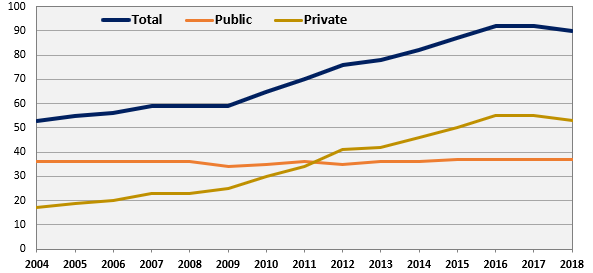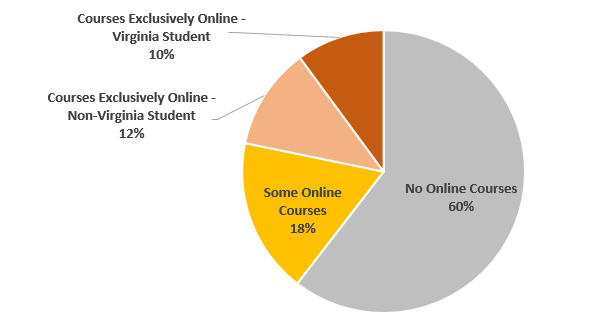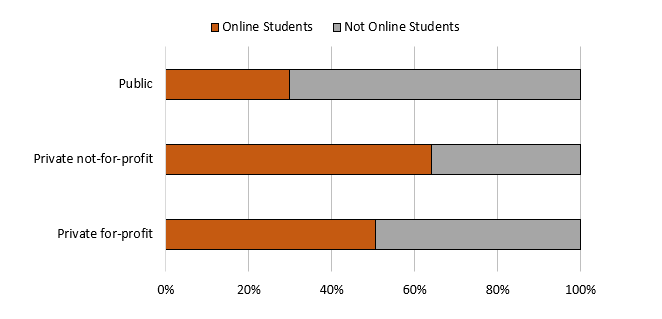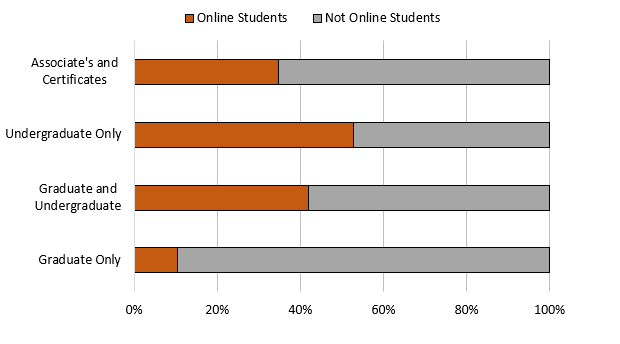Online higher education in Virginia (before the pandemic)
As a result of COVID-19, higher education institutions across the U.S. had to quickly transition from in-person to online courses for the Spring 2020 semester. In Virginia, the number of students completing coursework entirely online jumped from 120,000 to over half a million in a matter of weeks. Colleges and universities are now preparing scenarios that will shape not only the next few months, but also the next several years. Their decisions and preparations—previous and future—will likely determine their survival in a setting of already decreasing enrollments.
Some institutions have a head start in online instruction. In Virginia, just over half of post-secondary institutions offered at least one online education course and nearly 40 percent of students enrolled in at least one online course, which is higher than the national figure of 35 percent. Online learning in Virginia has been on a steady rise over the past 15 years, but future trends will depend on how institutions adapt to a more virtual environment.
Distance learning trends for Virginia
The number of higher education institutions in Virginia that offer online education opportunities has gradually increased since the data was first reported in 2004. However, the data shows that in recent years that number has stalled at around 90 out of 160 Virginia institutions*. Nearly all growth has come from private institutions as public institutions have consistently offered online courses since 2014.

Source: U.S. Department of Education’s National Center for Education Statistics (NCES), Integrated Postsecondary Education Data System (IPEDS)
In terms of enrollment, the percentage of Virginia students taking at least one online course was nearly 40 percent in 2018 (shown by the orange and yellow portions of figure 2), compared to 33 percent nationally. This figure has increased about 5 percentage points since 2012 even while enrollment in Virginia colleges and universities has decreased over the same period.

Source: U.S. Department of Education’s National Center for Education Statistics (NCES), Integrated Postsecondary Education Data System (IPEDS)
In 2018, just over one in five students attending Virginia institutions completed courses exclusively online, mostly through Liberty University, and most were from out of state.
Figure 3, which shows the percent of online students by public and private institutions, reveals that private schools are more likely to have students enrolled in online courses. In 2018, 64 percent of students at not-for-profit schools, such as Liberty, completed an online course, compared to only 50 percent of students at for-profit schools, such as ECPI, and 33 percent of students at public schools.

Source: U.S. Department of Education’s National Center for Education Statistics (NCES), Integrated Postsecondary Education Data System (IPEDS)
Figure 4 shows the percent of online students by college type. In undergraduate-only institutions more than half of the enrollment is through online courses, which is the highest rate of all institutions. Institutions that award certificates or associate’s degrees and those that award only graduate degrees are most commonly thought to have many online students. However, we see that only 33 percent of students from schools offering only associate’s degrees and certificates and fewer than 10 percent of students from graduate-only institutions enrolled in an online course.

Source: U.S. Department of Education’s National Center for Education Statistics (NCES), Integrated Postsecondary Education Data System (IPEDS)
Figure 5 shows the colleges with the largest online enrollments. Liberty University was an early adopter to distance learning, starting its online programs officially in 2004. In 2018, nine out of ten Liberty students were taking at least one online course—leading Virginia at just over 70,000 students. The institutions with the next highest online enrollment (three public four-year universities and two community colleges) trail far behind Liberty with only around 10,000 to 12,000 students at each taking a virtual class.

Source: U.S. Department of Education’s National Center for Education Statistics (NCES), Integrated Postsecondary Education Data System (IPEDS)
Figure 6 (below), which maps the top ten schools by online enrollment, shows that Liberty University enrolls the highest proportion of online students in Virginia. Of all students who took at least one online course in Virginia, one third did so through Liberty University. See this link for a complete listing of all Virginia institutions.
Figure 6: Online Enrollment distribution among Virginia Schools
Moving Forward
Online education existed in the Commonwealth at varying degrees prior to the COVID-19 pandemic that forced all learning online. Over the past decade, virtual learning has seen steady growth, yet much of this growth has occurred at only a few institutions. It will be interesting to see how the availability and consumption of online courses will trend moving forward. This temporary, forced move to remote education may end up as a blip on the radar or COVID-19 may accelerate a shift to online learning among institutions if it proves to be an effective mode of learning.
For online instruction to be most effective, higher education leaders will need to learn from those with more experience in order to address some of the challenges of virtual learning. Among many issues, institutions must combine efforts to address the following:
- The lack of computer and internet access for a portion of the population severely affects students’ ability to access online offerings. High-speed internet is a necessity when participating in online courses, and it is not available everywhere. In addition, financial aid may need to adapt to cover the costs of internet access and computers. This digital divide may worsen educational inequities among groups.
- Online learning requires discipline, favoring motivated students and leaving other students to struggle, which can further exacerbate educational inequalities.
- Different types of courses can more easily transition to a virtual environment than others. Classes with a lab or hands-on component will not convert to distance learning as effectively as an economics course, for example.
- The cost of higher education will need to be re-evaluated as an online education is less expensive (and possibly less valued) than a face-to-face educational experience. Colleges and universities may have to address their budget models to invest less in capital projects and residential campuses and more in digital infrastructure.
- How will an online environment affect a student’s college experience? An on campus experience provides invaluable face-to-face interactions with faculty and peers, and amenities such as gyms, libraries, sports, arts, and entertainment. Will students and parents be willing to trade a traditional residential experience for an online college education, which lacks the vital in-person interactions and amenities, but may offer a more flexible and less expensive college education?
___________________
*Data in this analysis includes all post-secondary colleges, universities, and technical and vocational institutions that participate in federal student financial aid programs.


